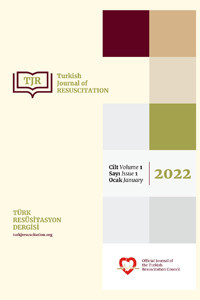ÇOKLU BAŞARILI RESÜSİTASYON VE AKUT KORONER SENDROMLU HASTAYA YAKLAŞIM
Kalp durması, Pnömotoraks, Kardiyopulmoner resüsitasyon, Miyokardiyal İnfarktüs, Akut koroner sendrom
MULTIPLE SUCCESSFUL RESUSCITATION AND APPROACH TO PATIENT WITH ACUT CORONARY SENDROM
Cardiac arrest, Pneumothorax, Cardiopulmonary resuscitation, Myocardial infarction, Acute coronary sendrom,
___
- Chiota NA, Freeman WD, Barrett KM. Hypoxic-ischemic brain injury and prognosis after cardiac arrest. Continuum (Minneap Minn) 2011; 17: 1094-1118.
- European Heart Network. European Cardiovascular Disease Statistics. 2012 edition.
- Thygesen K, Alpert JS, Jaffe AS et all. Third universal definition of myocardial infarction. Eur Heart J 2012;33(20):2551–2567.
- Roffi M, Patrono C, Collet JP et. all 2015 ESC Guidelines for the management of acute coronary syndromes in patients presenting without persistent ST-segment elevation: Task Force for the Management of Acute Coronary Syndromes in Patients Presenting without Persistent ST-Segment Elevation of the European Society of Cardiology (ESC). Eur Heart J 2016;37(3):267–315.
- Townsend N, Wilson L, Bhatnagar P, Cardiovascular disease in Europe: epidemiological update 2016. Eur Heart J 2016;37(42):3232–3245
- Larsen JM, Ravkilde J. Acute coronary angiography in patients resuscitated from out-of-hospital cardiac arrest: a systematic review and meta-analysis. Resuscitation 2012;83(12):1427– 1433.
- Twerenbold R, Neumann JT, Sorensen NA, et. all Prospective validation of the 0/1-h algorithm for early diagnosis of myocardial infarction. J Am Coll Cardiol 2018;72:620632
- http://resusitasyon.org/tr/kilavuzlar-resusitasyon-rehberi/69-avrupa-resusitasyon-konseyi-2015-resusitasyon-rehberigenis-ozet.html
- https://www.uptodate.com/contents/image?topicKey=CARD%2F963&search=overview%20of%20sudden%20cardiac%20t&imageKey=CARD%2F62184&rank=1~150&source=see_link
- Lambert L, Brown K, Segal E, et. all Association between timeliness of reperfusion therapy and clinical outcomes in STelevation myocardial infarction. JAMA. 2010;303(21):2148
- Kardiyak arrest sonrası hedeflenmiş sıcaklık yönetimi ulusal tedavi klavuzu. Eylül Ofset Matbaa ve Reklam Hizm.Sn.Tic.Ltd.Şti. 2020,1.Baskı, İstanbul, ISBN : 978-605-70043-0-7
- Başlangıç: 2022
- Yayıncı: Resüsitasyon Derneği
DOKUZ EYLÜL ÜNİVERSİTESİ TIP FAKÜLTESİ HASTANESİNDE MAVİ KOD UYGULAMALARININ DEĞERLENDİRİLMESİ
Neslihan TÜTÜNCÜ KILIÇ, Bahar KUVAKİ, Şule ÖZBİLGİN, Mert İNCESU
Aslı KARSLI KOÇ, Hatice Evren EKER, Çağla Etike BALİ, Anış ARIBOĞAN, Şule AKIN
ÇOKLU BAŞARILI RESÜSİTASYON VE AKUT KORONER SENDROMLU HASTAYA YAKLAŞIM
Tarık KAÇAR, Ali ALAGÖZ, Gönül TEZCAN KELEŞ
NEFESLE BAŞLAR YOLCULUK!: KARDİYOPULMONER RESÜSİTASYONDA TARİHSEL BİR GEZİNTİ
Nurcan DORUK, Levent ÖZDEMİR, Aslınur SAGÜN, Bahar TAŞDELEN, Merve KÖK, Enes YEŞİLMEN
Y. Levent UĞUR, Murat ÖZÇELİK, Şule ÖZBİLGİN, Bahar KUVAKİ, Necati GÖKMEN
